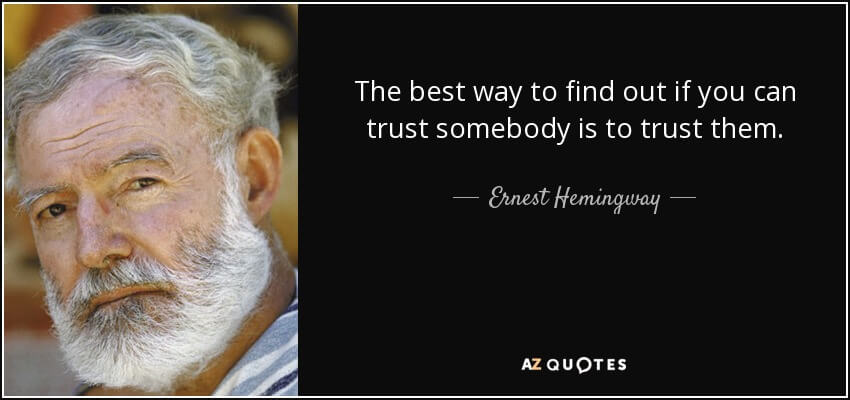
Trust is at the heart of every relationship in life, personal and professional.
How do we build trust?
Sometimes we need to take a lot of time and patience to build trust, we analyse, assess, look for evidence and proof points.
Sometimes, though, perhaps Hemingway’s quote can be our anchor.
The best way to find out if you can trust somebody is to trust them
So, before giving some thoughts and examples of choosing to trust, let me first recognise that proof points, analysis, evidence, time are all absolutely valid in building and maintaining trust.
Where do I sit in both a personal space and also from my leadership experience? I believe that there is always a balance between choosing to trust and building trust empirically.
There are no absolutes in life. No absolute proof, no absolute guarantees, so there is always an element of choosing to trust.
In terms of the speed of building trust though, choosing to trust someone is absolutely the way to find out if you can trust them, as well as being the fastest way to find out. It can feel risky, as you may find out you can’t trust them. This can mean that you feel at risk as you choose to trust. You can, however, create boundaries and, in professional rather than personal life, sets of rules, compliance procedures etc. Trust then verify, perhaps!
So for today, three thoughts on this.
James Timpson
I love following James Timpson on Twitter. An inspiring leader from a family business that absolutely is built on trust and empowerment.
The easiest way to create a culture of kindness in an organisation is to trust everyone to do what they think is right…every time a decision needs to be made. No trust equals high colleague turnover, poor sales and lower profits.
— James Timpson (@JamesTCobbler) October 9, 2018
I’ve followed the Timpson leadership from some time and they absolutely choose to trust, allied to simple structures and rules, boundaries if you will.
Patience Wheatcroft
Patience is a massively experienced business leader who writes a wonderful column each week in the Sunday Times.
From her column on January 13th 2019, entitled “Let the team use their heads — and not lose them if it doesn’t work out”, focussed on empowerment within structures :
“Empowerment, along with “flat” management structures and devolved decision-making, was big in management speak before the 2008 crash. Inevitably, recession prompted a return to more conservative norms and the “command and control” structure took over again in many companies. However, the evidence is that giving staff a degree of autonomy pays off, even if it is not a magical cure for all business ills.”
“..workers need to feel they are able to take decisions but that requires a supportive corporate framework. Companies that truly believe in empowerment use mentoring schemes and staff development programmes. And they do set boundaries: employees have freedom of action . . . up to a point.”
“Bosses need to decide how far they will trust the judgment of staff and what guidelines should be in place.”
“Of course, when people use their judgment, they sometimes make mistakes. If staff are given the authority to make decisions, the evidence is that it will increase their trust in their employers and their loyalty to the business. This approach, however, will not yield real dividends unless they feel the occasional mistake will not blight their career prospects. Empowerment may lead to improvement but it cannot produce perfection.”
Jan Carlzon
In my first job after working in the accountancy profession, I joined Cayman Airways as a 25 year old Financial Controller. In hindsight that was quite a leap of trust they took in me!
Anyway, as I joined, the Managing Director, Kel Thompson, gave me the first business leadership book I ever read, Moments of Truth by Jan Carlzon.
I loved it, immediately buying a lot of copies and sharing them around the business.
His book was about the importance of the “moments of truth” that front line staff at his airline (SAS) had for the business, for customer moments, for opportunities to either create or destroy customer loyalty and general sense of positivity towards the business.
I love that book and, at the heart of it, is, once again, the choice to trust and then empower. Once you make that choice, you must then reconfigure your business to get all necessary information to the fingertips of those frontline staff. Imagine you have an issue with your airline at the airport and the person you are talking to has to wait to hear from someone one or two rungs up the ladder before they can resolve your issue. Not a positive experience. If, instead, they can both have the information at their fingertips and be empowered to act, what a difference that makes.
I lead lots of businesses over about two decades that had front line customer service at their core. I always chose to trust people first, then made sure that the business was structured around trust.
So, in closing today, what are your own thoughts around the balance of trust and control? I’d love to hear from you.
